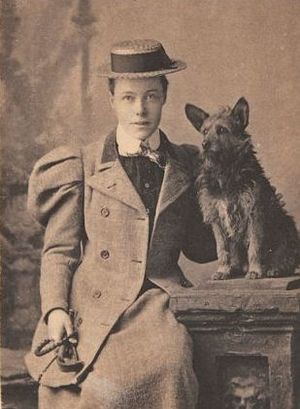Kate Williams Evans facts for kids
Kate Williams Evans (born October 1, 1866 – died February 2, 1961) was a Welsh suffragette. She was an activist and campaigner who worked hard for women's rights. This meant she believed women should have the right to vote. She was put in Holloway Prison because of her activism. While there, she went on a hunger strike, which means she refused to eat as a protest. For this, she received a special award called the WSPU's Hunger Strike Medal. This medal was later sold to the National Museum Wales in 2018 for a lot of money.
Contents
Kate Williams Evans: Her Life and Fight
Early Life and Interest in Women's Rights
Kate Williams Evans was born in 1866 in a place called Llanymynech in Montgomeryshire, Wales. Her father, William Dorsett Evans, was a successful farmer. She grew up with one brother and three sisters. By 1891, she was living with her family on their farm, Bod Gwilym, in Llansantffraid-ym-Mechain.
When she was younger, Kate became very interested in politics. During a trip to Paris in the 1890s, she learned about the idea of women's suffrage, which is the right for women to vote. When she came back home, she met people from the Women's Social and Political Union (WSPU). This group was very active in fighting for women's voting rights. By her mid-30s, Kate was an active member of the WSPU and became a suffragette. This made her parents a bit disappointed, but Kate was determined.
Fighting for the Right to Vote
In March 1912, Kate was arrested. She was accused of damaging government office windows in London. She did this as a protest, along with other suffragettes like Caroline Lowder Downing and Edith Downing. For this, she was sentenced to 54 days of difficult work in Holloway Prison.
While in prison, Kate went on a hunger strike. This was a common way for suffragettes to protest their treatment and to draw attention to their cause. Because of her hunger strike, she was given the WSPU's Hunger Strike Medal and a special Holloway brooch when she was released. Her Hunger Strike Medal has two silver bars, and one of them has the date '4 March 1912' engraved on it.
Later Activism and Legacy
In August 1913, Kate led a meeting for another group called the Women's Freedom League (WFL) in Llansantffraid-ym-Mechain. She talked about the differences between the WSPU and the WFL. Some people believe that after her time in Holloway Prison, she might have joined the WFL because it was a less forceful group than the WSPU. She continued to be involved with the WFL and was its chairperson until at least 1917.
By 1939, Kate and her sister Margaret were living together at their family farm, Bod Gwylim, in Wales. They stayed there for the rest of their lives. Kate Williams Evans passed away in February 1961 at a hospital in Oswestry. Her ashes are buried with her sister Margaret's. She left behind her belongings and money to her family.
Kate's Special Medal and Papers
In 2018, Kate Williams Evans's Hunger Strike Medal and Holloway brooch were sold at an auction. Also included in the sale were her old papers. These papers included her Metropolitan Police arrest warrant and an autograph book. This book had signatures from famous suffragettes like Emily Davison, Emmeline Pankhurst, and Sarah Benett.
The sale also featured a rare copy of a book called Holloway Jingles. This book was a collection of poems written by suffragettes who were in prison. Kate contributed three poems to this book, two of which were called "Who?" and the third "The Cleaners of Holloway". There was also a letter signed by Emmeline Pankhurst. Another interesting item was a handwritten letter from a fellow suffragette, Sarah Benett, to her maid. It said: 'Miss Evans will be my guest till she is a little stronger. She has been starving so treat her as an invalid...' These items were sold on behalf of Kate's family.
The entire collection was bought for £48,640. Today, the Hunger Strike Medal is kept at the National Museum Wales, where many people can see it and learn about Kate Williams Evans's brave fight for women's rights.


